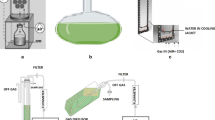Abstract
The marine diatom Haslea ostrearia was immobilized in a tubular agar gel layer introduced into a photobioreactor of original design with internal illumination for the continuous synthesis of marennin, a blue-green pigment of biotechnological interest. Marennin was produced for a long-term period (27–43 days) and the volumetric productivity was maximum (18.7 mg day−1 l−1 gel) at the highest dilution rate (0.25 day−1) and lowest agar layer thickness (3 mm). Heterogeneous cell distribution in the agar layer revealed diffusional limitation of light and nutrients. However, the 3 mm gel thickness led to a more homogeneous cell distribution during incubation and to an increase of the whole biomass in the agar gel layer.
Similar content being viewed by others
Author information
Authors and Affiliations
Additional information
Received: 22 October 1999 / Received revision: 14 February 2000 / Accepted: 18 February 2000
Rights and permissions
About this article
Cite this article
Lebeau, T., Gaudin, P., Junter, GA. et al. Continuous marennin production by agar-entrapped Haslea ostrearia using a tubular photobioreactor with internal illumination. Appl Microbiol Biotechnol 54, 634–640 (2000). https://doi.org/10.1007/s002530000380
Issue Date:
DOI: https://doi.org/10.1007/s002530000380




